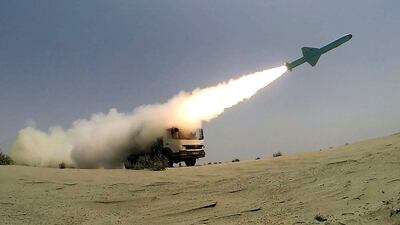Cruise missiles have significantly proliferated with dozens of states including Iran now in possession of advanced models, a new report shows.
With improved guidance systems, the weapons are now able to fly more complex missions, including swarm attacks similar to that carried out by Iran against a Saudi Aramco oil base in 2019.
The European Leadership Network investigation said that the increasing adoption of “multi-effect warheads” means that cruise missiles will become far more destructive with an increasing number of countries making nuclear-tipped weapons.
“The proliferation of cruise missiles has far-reaching strategic implications,” it said. “In a strained regional context this has the potential to undermine conventional and nuclear crisis stability.”
While current missiles were powered with liquid-fuel turbojet and turbofan engines, making them travel at a relatively mild Mach 1 or 1,230kph, the possibility of solid-fuel ramjets being developed could make them six times faster at 7,400kph and very difficult to defend against.
A main reason for the proliferation is the rise of effective American ballistic missile defence systems, such as Patriot missiles or the Arleigh Burke and Zumalt class destroyers.
"States like China and Russia, and also Iran, have been driven towards ballistic-missile alternatives, including cruise missiles," the report said.
It noted that Iran’s cruise missile programme benefited greatly from illegal transfers of Russian air-launched Kh-55s from Ukraine, which have a range of 2,500 kilometres.
The report highlighted the export of Russian-made SSN-27 Sizzler cruises missiles to Iran that have a range of 300km, a speed of nearly Mach 1 and carry a 450-kilogram warhead.
The report, Cruise Missile Proliferation, said that the numbers have grown significantly, creating a danger of nuclear strikes.
“Today, dozens of states are in possession of advanced cruise-missile capabilities, including both anti-ship and land-attack cruise missiles. In addition, nuclear-capable cruise missiles have proliferated significantly, a trend that can be expected to continue in the future.”
The ELN, a non-partisan group of 200 past, present and future European leaders, urged for a “comprehensive trilateral dialogue” between the US, Russia and China.
The authors offered suggestions to counter the potentially deadly consequences of cruise missile proliferation.
"A proactive attitude is required in order to counter the negative strategic implications of cruise missile proliferation and to reverse this dangerous proliferation trend," the report said.
“The international community should pursue a short-term agenda of establishing confidence and transparency-building measures surrounding the deployment and use of cruise missiles, while focusing on comprehensive and verifiable arms control agreements in the long term.”


